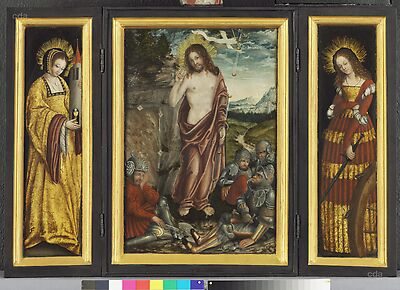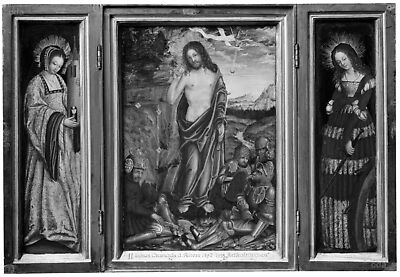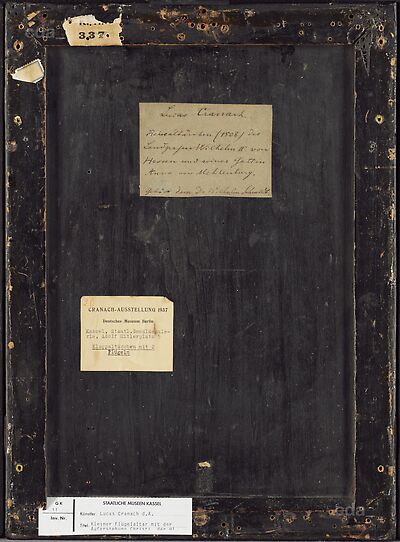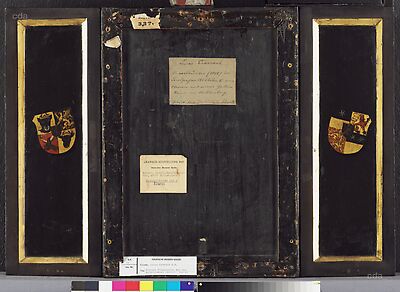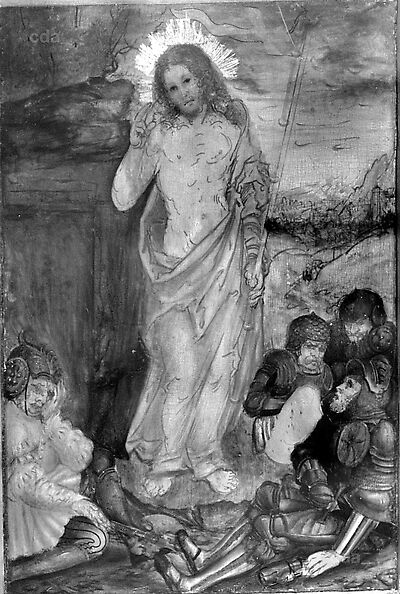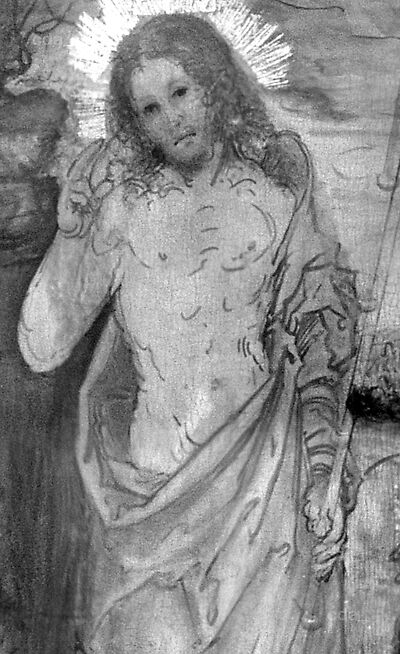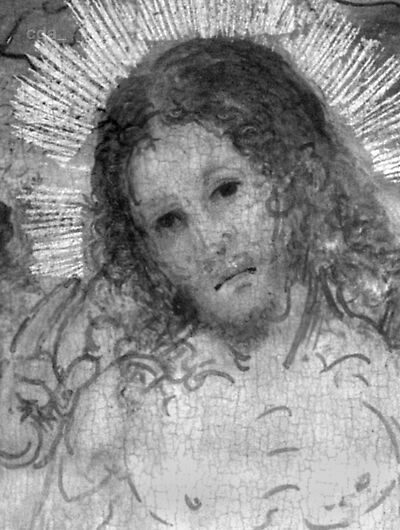| Exhib. Cat. Düsseldorf 2017 |
120 |
No. 23 |
|
| Editor | Gunnar Heydenreich, Daniel Görres, Beat Wismer |
|---|
| Title | Lucas Cranach der Ältere. Meister - Marke - Moderne. [anlässlich der Ausstellung "Cranach. Meister - Marke - Moderne", Stiftung Museum Kunstpalast, Düsseldorf, 08. April 2017 - 30. Juli 2017] |
|---|
| Place of Publication | Munich |
|---|
| Year of Publication | 2017 |
|---|
|
| Exhib. Cat. Gotha, Kassel 2015 |
98, 99 |
3 |
Pl. p. 99 |
| Editor | Julia Carrasco, Justus Lange, Benjamin D. Spira, Timo Trümper, Stiftung Schloss Friedenstein, Gotha |
|---|
| Title | Bild und Botschaft. Cranach im Dienst von Hof und Reformation, [Gotha, Herzogliches Museum; Kassel, Gemäldegalerie Alte Meister, Schloss Wilhelmshöhe] |
|---|
| Place of Publication | Heidelberg |
|---|
| Year of Publication | 2015 |
|---|
|
| Lange 2015 |
31-33 |
|
Figs. 4, 5 |
| Author | Justus Lange |
|---|
| Title | Lucas Cranach und die Landgrafschaft Hessen |
|---|
| Publication | in Julia Carrasco, Justus Lange, Benjamin D. Spira, Timo Trümper, Stiftung Schloss Friedenstein Gotha and Museumslandschaft Hessen Kassel, eds., Bild und Botschaft. Cranach im Dienst von Hof und Reformation, [Exhib. Cat. Gotha, Kassel] |
|---|
| Place of Publication | Heidelberg |
|---|
| Year of Publication | 2015 |
|---|
| Pages | 29-42 |
|---|
|
| Exhib. Cat. Coburg 2010 |
181-182 |
No. 1.2.13 |
Fig. 1.2.13 |
| Editor | LWL-Museum für Kunst und Kultur, Münster, Klaus Weschenfelder, Beate Böckum, Ruth Hansmann, Matthias Müller |
|---|
| Title | Apelles am Fürstenhof, Facetten der Hofkunst um 1500 im Alten Reich |
|---|
| Place of Publication | Berlin |
|---|
| Year of Publication | 2010 |
|---|
|
| Exhib. Cat. Frankfurt 2007 |
164-165 |
23 |
p. 165 |
| Editor | Bodo Brinkmann |
|---|
| Title | Cranach der Ältere, [Frankfurt, Städel Museum, 23 Nov 2007 - 17 Feb 2008] |
|---|
| Place of Publication | Ostfildern |
|---|
| Year of Publication | 2007 |
|---|
|
| Heydenreich 2007 A |
63, 77, 119, 120, 122, 124, 140, 187, 219, 291, 394 |
|
98, 108, 109 |
|
|
| Exhib. Cat. Eisenach 1998 |
158-159 |
No. 17.4 |
Figs. 17.4, 17.4a |
| Editor | Wartburg-Stiftung, Eisenach, Fachhochschule , Ingo Sandner |
|---|
| Title | Unsichtbare Meisterzeichnungen auf dem Malgrund. Cranach und seine Zeitgenossen. Ausstellungskatalog und Tagungsband Katalogteil 1; 2: Werkstatt und Schüler Cranachs; 3: Süddeutsche Meister; 4: Albrecht Dürer und sein Kreis; 5: Rheinische Meister |
|---|
| Place of Publication | Regensburg |
|---|
| Year of Publication | 1998 |
|---|
| Pages | 229-240 |
|---|
|
| Grimm 1998 |
68 |
|
Fig. 9.1 |
| Author | Claus Grimm |
|---|
| Title | Die Anteile von Meister und Werkstatt. Zum Fall Lucas Cranach d.Ä. |
|---|
| Publication | in Ingo Sandner, Wartburg-Stiftung Eisenach and Fachhochschule Köln, eds., Unsichtbare Meisterzeichnungen auf dem Malgrund. Cranach und seine Zeitgenossen, Exhib. Cat. Eisenach |
|---|
| Place of Publication | Regensburg |
|---|
| Year of Publication | 1998 |
|---|
| Pages | 67-82 |
|---|
|
| Heydenreich 1998 A |
188 |
|
|
| Author | Gunnar Heydenreich |
|---|
| Title | Herstellung, Grundierung und Rahmung der Holzbildträger in den Werkstätten Lucas Cranachs d.Ä. |
|---|
| Publication | in Ingo Sandner, Wartburg-Stiftung Eisenach and Fachhochschule Köln, eds., Unsichtbare Meisterzeichnungen auf dem Malgrund. Cranach und seine Zeitgenossen, Exhib. Cat. Eisenach |
|---|
| Place of Publication | Regensburg |
|---|
| Year of Publication | 1998 |
|---|
| Pages | 181-200 |
|---|
|
| Sandner 1998 B |
88 |
|
|
| Author | Ingo Sandner |
|---|
| Title | Cranach als Zeichner auf dem Malgrund |
|---|
| Publication | in Ingo Sandner, Wartburg-Stiftung Eisenach and Fachhochschule Köln, eds., Unsichtbare Meisterzeichnungen auf dem Malgrund. Cranach und seine Zeitgenossen, Exhib. Cat. Eisenach |
|---|
| Place of Publication | Regensburg |
|---|
| Year of Publication | 1998 |
|---|
| Pages | 83-95 |
|---|
|
| Cat. Kassel 1997 |
53-58 |
|
|
| Author | Anja Schneckenburger-Broschek |
|---|
| Editor | Staatliche Museen Kassel |
|---|
| Title | Altdeutsche Malerei. Die Tafelbilder und Altäre des 14. bis 16. Jahrhunderts in der Gemäldegalerie Alte Meister und im Hessischen Landesmuseum Kassel. Bestandskatalog Staatliche Museen Kassel |
|---|
| Place of Publication | Munich |
|---|
| Year of Publication | 1997 |
|---|
|
| Cat. Kassel 1996 |
87 |
|
p. 96 |
| Editor | Bernhard Schnackenburg |
|---|
| Title | Gesamtkatalog Gemäldegalerie Alte Meister. Staatliche Museen Kassel |
|---|
| Place of Publication | Mainz |
|---|
| Year of Publication | 1996 |
|---|
|
| Erichsen 1994 A |
151, 156 |
|
|
| Author | Johannes Erichsen |
|---|
| Title | Altäre Lucas Cranachs und seiner Werkstatt vor der Reformation |
|---|
| Publication | in Claus Grimm, Johannes Erichsen, Evamaria Brockhof, eds., Lucas Cranach. Ein Maler-Unternehmen aus Franken, Exhib. Cat. Kronach 1994 |
|---|
| Series | Veröffentlichungen zur bayerischen Geschichte und Kultur |
|---|
| Volume | 26/94 |
|---|
| Place of Publication | Augsburg, Regensburg |
|---|
| Year of Publication | 1994 |
|---|
| Pages | 150-165 |
|---|
|
| Exhib. Cat. Kronach 1994 |
315, 371 |
134 |
Fig. 134 |
| Editor | Claus Grimm, Johannes Erichsen, Evamaria Brockhoff |
|---|
| Title | Lucas Cranach. Ein Maler-Unternehmer aus Franken [Festung Rosenberg, Kronach 17.05 - 21.08.1994; Museum der Bildenden Künste, Leipzig 07.09 - 06.11.1994] |
|---|
| Series | Veröffentlichungen zur bayerischen Geschichte und Kultur |
|---|
| Volume | 26 |
|---|
| Place of Publication | Augsburg, Coburg |
|---|
| Year of Publication | 1994 |
|---|
|
| Cat. Kassel 1982 |
15, 61, 62 |
|
p. 82 |
| Author | Anja Schneckenburger-Broschek |
|---|
| Title | Die Altdeutsche Malerei. Staatliche Kunstsammlungen Kassel |
|---|
| Place of Publication | Kassel |
|---|
| Year of Publication | 1982 |
|---|
|
| Friedländer, Rosenberg 1979 |
|
017 |
|
| Author | Max J. Friedländer, Jakob Rosenberg |
|---|
| Editor | G. Schwartz |
|---|
| Title | Die Gemälde von Lucas Cranach |
|---|
| Place of Publication | Basel, Boston, Stuttgart |
|---|
| Year of Publication | 1979 |
|---|
|
| Exhib. Cat. Basel 1974/1976 |
409, 452-453, 552, 555, 683 |
No. 294 |
Pl. 25 |
|
|
| Koepplin 1974 A |
25, 26 |
|
I |
| Author | Dieter Koepplin |
|---|
| Title | Zwei Fürstenbildnisse Cranachs von 1509 |
|---|
| Journal | Pantheon |
|---|
| Issue | 32 |
|---|
| Year of Publication | 1974 |
|---|
| Pages | 25-34 |
|---|
|
| Schade 1974 |
85 |
|
|
|
|
| Cat. Kassel 1969 |
11 |
|
|
| Author | E. Herzog |
|---|
| Title | Die Gemäldegalerie der Staatlichen Kunstsammlungen Kassel |
|---|
| Place of Publication | Hanau |
|---|
| Year of Publication | 1969 |
|---|
|
| Koepplin 1966 |
83 |
|
|
| Author | Dieter Koepplin |
|---|
| Title | Lucas Cranachs Heirat und das Geburtsjahr des Sohnes Hans |
|---|
| Journal | Zeitschrift des deutschen Vereins für Kunstwissenschaft |
|---|
| Issue | 20 |
|---|
| Year of Publication | 1966 |
|---|
| Pages | 79-84 |
|---|
|
| Cat. Kassel 1958 |
47 |
11 |
|
| Author | Heinrich Vogel |
|---|
| Title | Katalog der Staatlichen Gemäldegalerie zu Kassel |
|---|
| Place of Publication | Kassel |
|---|
| Year of Publication | 1958 |
|---|
|
| Exhib. Cat. Berlin 1937 |
16 |
012 |
Pl. 19 |
| Editor | Staatliche Museen, Berlin |
|---|
| Title | Lucas Cranach d. Ä. und Lucas Cranach d. J. Gemälde, Zeichnungen, Graphik |
|---|
| Place of Publication | Berlin |
|---|
| Year of Publication | 1937 |
|---|
|
| Exhib. Cat. Marburg 1932 |
130-131 |
150 |
|
| Editor | Hermann Deckert, Robert Freyhan, Kurt Steinbart |
|---|
| Title | Religiöse Kunst aus Hessen und Nassau. Kritischer Gesamtkatalog der Ausstellung Marburg 1928 |
|---|
| Place of Publication | Marburg |
|---|
| Year of Publication | 1932 |
|---|
|
| Friedländer, Rosenberg 1932 |
|
017 |
|
|
|
| Cat. Kassel 1929 |
18, 99 |
11 |
|
| Author | K. Luhmer |
|---|
| Title | Katalog der Staatlichen Gemäldegalerie zu Kassel |
|---|
| Place of Publication | Berlin |
|---|
| Year of Publication | 1929 |
|---|
|
| Glaser 1923 |
75-76 |
|
|
|
|
| Cat. Kassel 1913 |
|
|
|
| Author | G. Gronau |
|---|
| Title | Katalog der Königlichen Gemäldegalerie zu Cassel. Amtliche Ausgabe |
|---|
| Place of Publication | Berlin |
|---|
| Year of Publication | 1913 |
|---|
|
| Swarzenski 1907 |
50 |
|
|
| Author | Georg Swarzenski |
|---|
| Title | Cranachs Altarbild von 1509 im Städelschen Kunstinstitut zu Frankfurt/M |
|---|
| Journal | Münchner Jahrbuch der bildenden Kunst |
|---|
| Issue | 2 |
|---|
| Year of Publication | 1907 |
|---|
| Pages | 49-65 |
|---|
|
| Eisenmann 1904 |
306 |
|
|
| Author | Oskar Eisenmann |
|---|
| Title | Über einige Bildnisse Philipps und die Beziehungen seiner Eltern zu Lucas Cranach |
|---|
| Journal | Hessenland. Zeitschrift für hessische Geschichte und Literatur |
|---|
| Issue | 18 |
|---|
| Year of Publication | 1904 |
|---|
| Pages | 305-306 |
|---|
|
| Schmidt 1904 |
454-456 |
|
|
|
|
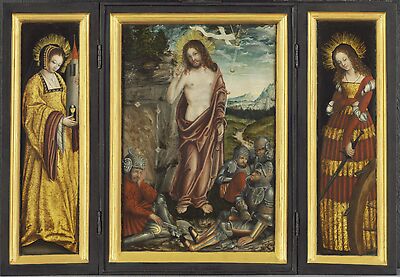

![Small retabel with the resurrection of Christ [central panel]](https://lucascranach.org/imageserver-2022/DE_MHK_GK11a_FR017/01_Overall/DE_MHK_GK11a_FR017_2013-05_Overall-s.jpg)
![Portable Altarpiece belonging to Landgrave Wilhelm II. of Hesse and Anna of Mecklenburg: St Barbara [left wing]](https://lucascranach.org/imageserver-2022/DE_MHK_GK11b_FR017/01_Overall/DE_MHK_GK11b_FR017_2013-05_Overall-s.jpg)
![Portable Altarpiece belonging to Landgrave Wilhelm II. of Hesse and Anna of Mecklenburg: St Catherine [right wing]](https://lucascranach.org/imageserver-2022/DE_MHK_GK11c_FR017/01_Overall/DE_MHK_GK11c_FR017_2013-05_Overall-s.jpg)
